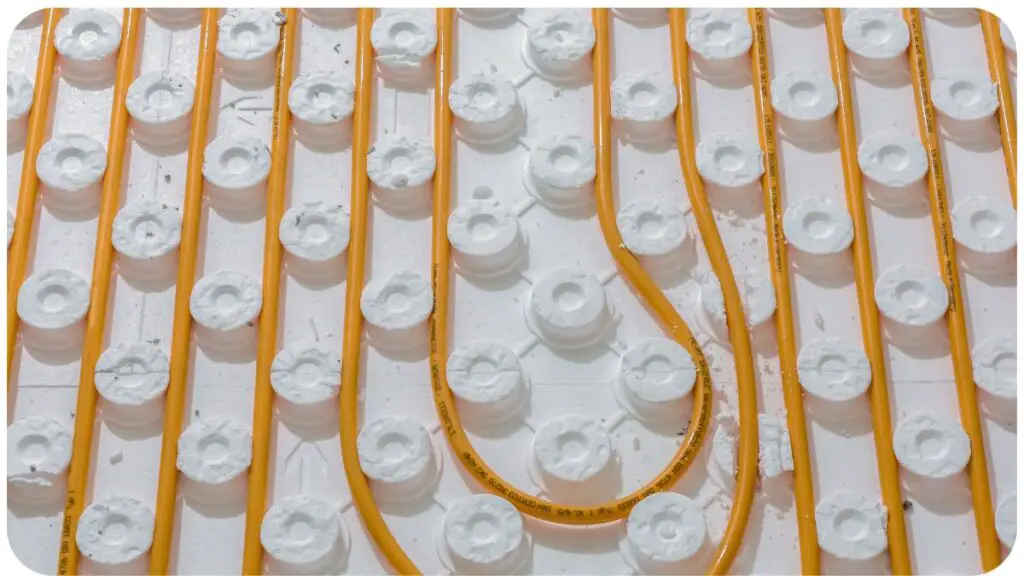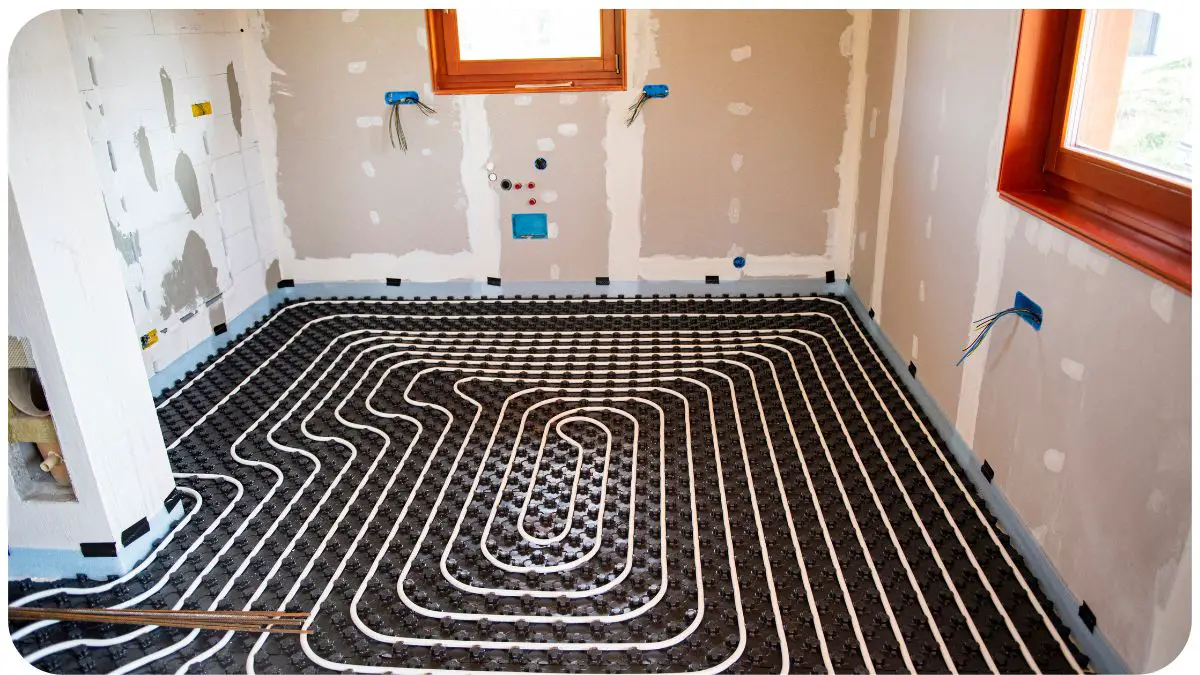When it comes to heating your bathroom, there are various options available, and one popular choice is in-floor heating. In-floor heating, also known as radiant floor heating, provides warmth by heating the floor surface.
This method offers a unique way to keep your bathroom cozy, but like any system, it has its pros and cons. In this article, we will explore the advantages and disadvantages of in-floor heating in your bathroom and help you decide if it’s the right choice for you.
| Takeaways |
|---|
| In-floor heating provides increased comfort in the bathroom by eliminating the discomfort of cold floors. |
| In-floor heating systems are energy efficient and can help reduce heating costs. |
| In-floor heating saves space in the bathroom as it is hidden beneath the floor surface. |
| Proper installation techniques and care can ensure optimal performance and longevity of the in-floor heating system. |
| In-floor heating may have higher upfront installation costs and require more time for installation compared to traditional heating methods. |
| It is important to choose flooring materials that are compatible with in-floor heating to avoid potential damage. |
| In-floor heating systems offer limited heat control options for individual temperature preferences in different areas of the bathroom. |
| Consider factors such as climate, flooring material, cost, and remodeling plans before deciding if in-floor heating is right for your bathroom. |
2. How Does In-Floor Heating Work?

In-floor heating systems utilize either electric or hydronic technology to warm the floor. Electric systems consist of heating cables or mats installed directly beneath the floor surface, while hydronic systems use hot water or a mixture of water and antifreeze circulating through plastic tubing. Both methods provide a comfortable heat source that radiates evenly across the floor, creating a warm and inviting bathroom environment.
Building a smart kitchen is incomplete without a stylish and efficient backsplash. Discover the dos and don’ts of installing a smart kitchen backsplash to elevate the aesthetics and functionality of your cooking space.
3. Pros of In-Floor Heating in Your Bathroom
Increased Comfort
One of the most significant advantages of in-floor heating in your bathroom is the enhanced comfort it provides. Walking barefoot on a cold floor can be an unpleasant experience, especially during colder months. With in-floor heating, the floor remains warm, offering a toasty sensation that makes your bathroom feel cozy and inviting.
Energy Efficiency
In-floor heating systems are known for their energy efficiency. Compared to traditional heating methods that rely on forced air or baseboard radiators, in-floor heating distributes warmth more evenly. This allows you to maintain a comfortable temperature in your bathroom without cranking up the thermostat, ultimately saving energy and reducing heating costs.
Upgrade your shower experience with a smart shower head. Learn the tips and tricks for replacing a smart shower head to enjoy customizable water settings and enhanced convenience during your daily routines.
No More Cold Feet
Say goodbye to icy toes when you step into your bathroom! In-floor heating effectively eliminates the discomfort of cold floors. Whether you’re getting ready in the morning or unwinding in a relaxing bubble bath, the warm floor will provide a soothing and enjoyable experience.
Space Saving
Unlike bulky radiators or heating vents, in-floor heating systems are hidden beneath the floor, offering a space-saving solution for your bathroom. With no need for additional heating elements, you have more freedom to arrange your bathroom furniture, maximize storage space, and create a streamlined layout.
Illuminate your bathroom with modern lighting solutions. Check out our practical guide on upgrading your bathroom lighting to create a soothing ambiance and improve the functionality of your personal sanctuary.
Silent Operation
In-floor heating operates silently, adding to the peaceful ambiance of your bathroom. Traditional heating systems can produce noise, like the hum of a forced-air furnace, which can be disruptive and annoying. In-floor heating ensures a serene environment, allowing you to fully enjoy moments of relaxation in your bathroom.
Table 1: Comparison of Electric and Hydronic In-Floor Heating
| Pros | Electric In-Floor Heating | Hydronic In-Floor Heating |
| Increased Comfort | Yes | Yes |
| Energy Efficiency | Yes | Yes |
| No More Cold Feet | Yes | Yes |
| Space Saving | Yes | Yes |
| Silent Operation | Yes | Yes |
| Installation Costs | Lower | Higher |
| Installation Time | Shorter | Longer |
| Floor Height Increase | Minimal | Minimal |
| Potential Damage to Flooring | Minimal | Minimal |
| Limited Heat Control | Yes | No |
Table 1 shows a comparison between electric and hydronic in-floor heating, highlighting their pros and cons.
Dealing with a leaky drain? Don’t worry! Our comprehensive guide on fixing a leaky drain provides step-by-step instructions and valuable insights to help you resolve the issue efficiently and prevent further damage.
Cons of In-Floor Heating in Your Bathroom

While in-floor heating offers numerous benefits, there are some potential drawbacks to consider:
Installation Costs
The initial installation cost of in-floor heating can be higher compared to other heating methods. Additional expenses include purchasing the heating system, cables or tubing, and the cost of labor if you hire a professional installer. However, these costs can vary depending on the size of the bathroom and the complexity of the installation.
Installation Time
Installing in-floor heating in your bathroom can take longer compared to traditional heating methods. The process involves careful planning, laying out the heating elements, connecting them to the power source or heat source, and ensuring proper insulation. The timeframe for installation can be extended if there are any unforeseen challenges or if you opt for a DIY approach.
Understanding dishwasher error codes is crucial for efficient troubleshooting. Explore our comprehensive guide to understanding your dishwasher error codes and gain insights into common problems, possible solutions, and preventive measures to keep your dishwasher running smoothly.
Floor Height Increase
In-floor heating systems require additional space beneath the floor surface to accommodate the heating elements. This might result in a slight increase in the overall floor height. While this is usually minimal, it is essential to consider if you have door clearances or other elements that could be affected by the raised floor height.
Potential Damage to Flooring
During the installation process, there is a possibility of damaging the existing flooring. This risk is higher if the flooring is brittle or delicate, such as ceramic tiles or natural stones. However, professional installers are experienced in handling such situations, minimizing the risk of damage. It’s important to discuss the potential risks with your installer beforehand and choose the appropriate flooring material.
Limited Heat Control
Some in-floor heating systems offer limited heat control options. While you can adjust the overall temperature of the system, achieving individual temperature control in specific areas of the bathroom might be challenging. This can be a disadvantage if you prefer different heat settings for different areas, such as a warmer floor by the bathtub and a slightly cooler floor near the vanity.
Table 2: Pros and Cons of In-Floor Heating in Your Bathroom
| Pros | Cons |
| Increased Comfort | Installation Costs |
| Energy Efficiency | Installation Time |
| No More Cold Feet | Floor Height Increase |
| Space Saving | Potential Damage to Flooring |
| Silent Operation | Limited Heat Control |
Table 2 summarizes the pros and cons of in-floor heating in your bathroom.
6. Is In-Floor Heating Right for Your Bathroom?
Deciding whether in-floor heating is the right choice for your bathroom depends on various factors. Consider the following:
- Climate: If you live in a colder region where the floors tend to be chilly, in-floor heating can greatly improve your comfort level.
- Flooring Material: Some flooring materials, like ceramic tiles or stone, tend to feel colder than others. In-floor heating can offset this coldness and provide a more pleasant experience.
- Cost Considerations: Evaluate your budget and determine if the upfront cost and potential long-term energy savings align with your financial goals.
- Remodeling Plans: If you’re embarking on a bathroom remodel or renovation, it may be an opportune time to incorporate in-floor heating while the flooring is being replaced.
Ultimately, the decision to install in-floor heating should be based on your personal preferences, lifestyle, and the specific requirements of your bathroom space.
7. Installation Tips for In-Floor Heating
If you decide to proceed with in-floor heating in your bathroom, here are some installation tips to ensure optimal performance:
Choosing the Right Flooring Material
Before selecting your flooring material, consider its compatibility with in-floor heating. Tile, stone, and engineered wood are popular choices as they conduct heat effectively. It’s best to consult with a flooring expert who can guide you towards materials that work well with in-floor heating.
Proper Installation Techniques
If you choose to hire a professional installer, ensure they have experience in working with in-floor heating systems. Proper installation is crucial for optimal performance and longevity. If you prefer a DIY approach, make sure to thoroughly read and follow the manufacturer’s instructions and guidelines.
Maintenance and Care
Following proper maintenance practices will ensure your in-floor heating system functions efficiently. Regularly clean the flooring surface, avoid sharp objects that could damage the heating elements, and address any issues promptly.
Monitoring and Control Systems
Consider investing in a monitoring and control system for your in-floor heating. These systems allow you to adjust and monitor the temperature, ensuring optimal comfort and energy efficiency. Some advanced systems can also be controlled remotely through smartphones or smart home devices.
8. Case Study: Lisa’s Experience with In-Floor Heating
To provide you with a real-world example, let’s take a look at Lisa’s experience with in-floor heating in her bathroom remodel:
Lisa’s Bathroom Remodeling Journey
Lisa had always dreamed of having a warm and cozy bathroom, especially during the cold winter months. When she decided to remodel her bathroom, she researched various heating options and ultimately chose in-floor heating.
During the remodeling process, Lisa consulted with a professional installer who guided her in selecting the right flooring material and efficiently laying out the heating system. She opted for ceramic tiles, which were not only visually appealing but also effectively conducted heat.
Benefits and Challenges
After the in-floor heating installation was complete, Lisa immediately noticed a significant improvement in comfort. Previously, she would dread stepping onto the cold floor in the mornings, but now she was greeted with a warm and inviting sensation. The in-floor heating provided a pleasant and cozy atmosphere, making her bathroom feel like a luxurious spa retreat.
However, Lisa did face some challenges during the installation process. Since her bathroom was relatively small, the increased floor height due to the heating elements required adjustments to the door clearance. Additionally, there was a minor delay in the installation timeline due to unforeseen issues with the existing plumbing.
Despite these challenges, Lisa believes that the pros of in-floor heating far outweighed the cons. The increased comfort, energy efficiency, and space-saving benefits made her bathroom remodel worth every penny. She now enjoys the luxury of a warm floor throughout the year without worrying about high heating bills.
9. Conclusion
In-floor heating in your bathroom can provide numerous benefits, including increased comfort, energy efficiency, and a cozy atmosphere. The space-saving nature and silent operation are also advantages that make in-floor heating an attractive option. However, it’s important to consider the potential drawbacks, such as installation costs, time, and potential flooring damage.
Before making a decision, evaluate your specific needs, budget, and the requirements of your bathroom space. Consulting with professionals and conducting thorough research will help you determine if in-floor heating is the right choice for you.
By weighing the pros and cons, considering factors like climate and flooring material, and following proper installation and maintenance practices, you can create a luxurious and inviting bathroom space with the warmth of in-floor heating. Embrace the comfort and enjoy stepping onto a cozy floor every day.
Further Reading
Here are some additional resources that provide more information on the pros and cons of in-floor heating in your bathroom:
- Pros and Cons of a Radiant Heated Bathroom Floor: This website discusses the benefits and drawbacks of installing radiant heated floors in your bathroom, including improved comfort and energy efficiency, installation costs, and potential damage to flooring.
- 9 Pros and Cons of Heated Floors: WarmlyYours explores the pros and cons of in-floor heating, highlighting the comfort, energy efficiency, and space-saving benefits, as well as installation costs, installation time, and temperature control limitations.
- Heated Bathroom Floors: Pros and Cons: This article discusses the advantages and disadvantages of heated bathroom floors, addressing topics such as comfort, energy efficiency, installation costs, and the impact on flooring choices.
FAQs
What is in-floor heating?
In-floor heating, also known as radiant floor heating, is a system that uses electric cables or hydronic tubing to heat the floor surface, creating a comfortable and cozy environment in bathrooms.
Is in-floor heating energy efficient?
Yes, in-floor heating is known for its energy efficiency. It provides more even heat distribution and can often reduce energy consumption compared to traditional heating methods.
What are the installation costs of in-floor heating?
The installation costs for in-floor heating can vary depending on factors such as the size of the bathroom and the complexity of the installation. Electric in-floor heating systems generally have lower installation costs compared to hydronic systems.
Can in-floor heating damage the flooring?
There is a possibility of damaging the flooring during the installation process, particularly if the flooring material is delicate or brittle. It’s important to discuss potential risks with professional installers and choose appropriate flooring materials that are compatible with in-floor heating.
Can I control the temperature of in-floor heating in specific areas of the bathroom?
While you can adjust the overall temperature of the in-floor heating system, achieving individual temperature control in specific areas of the bathroom might be challenging. Most systems offer limited heat control options, so it’s important to consider this when planning your bathroom layout.

Hellen James is the author of the blog and a licensed plumber with over 15 years of experience. She shares her knowledge and experience in plumbing and drainage through insightful and informative articles

